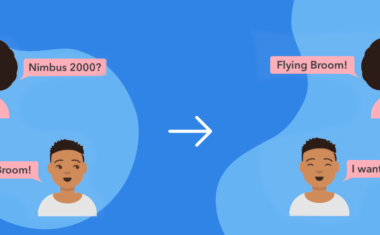Free UX Design Course
Dive into UX design with our free starter course. Transform your creative ideas into user-friendly solutions.
If you search on Glassdoor for UX jobs, you’ll find nearly 26,000 postings. UX is a growing, thriving field, and demand is at an all-time high.
User experience is about making products, websites, apps, and other pieces of technology as easy to use as possible. While aesthetics is a component of a good website or product, it’s not the primary goal of UX—function is. More specifically: UX designers are concerned with ways to make the product function as easily as possible so the consumer will want to use it.
In order to make a consumer-friendly product, a UX designer must understand the customer. What do they want? What motivates them? What do they like, what do they dislike, and what will keep them coming back? This is where a UX research comes in.
In order to better understand the difference between a UX researcher vs. UX designer, let’s take a look at what their primary roles and responsibilities are, what backgrounds are best suited for each, and what the salary range is for both.
UX Researcher vs. Designer: What’s The Difference?
In some companies (often smaller ones), the role of UX researcher and designer are performed by the same person. It’s advisable, however, to have a seperate UX research team and if you’re considering going into user experience or user research, it’s important to know what you’re getting yourself into. UX design and user research are very different.


Become A UX Designer. Land a Job or Your Money Back.
Master Adobe XD, Figma, and Sketch. Work 1:1 with an industry mentor. Build a portfolio. Land a job — or your money back.
Here are the key differences between a UX researcher vs. UX designer:
UX Researcher: Before a UX designer can begin the design stage of a project, he must understand who he is designing for. Who is the target market? What motivates them? How will the product improve their lives? Without these insights, it’s impossible to design a good product. Finding the answers to these questions is the role of a UX researcher and UX research.
As you can infer from the job title, a UX researcher’s main goal is research. A UX researcher analyzes consumer behavior and forms data-driven insights to address the needs of the consumers. Once they have these insights, they turn them over to the larger UX design team so they can create products that meet the needs of their audience.
User experience (UX) research is the process of understanding users, what they need, what they value, their abilities, and their limitations. It is a critical part of the design process, helping to ensure that products and services are user-friendly and meet the needs of the target audience.
There are a variety of UX research methods that can be used, including:
- User interviews: One-on-one or group interviews with users to gather insights about their needs, wants, and pain points.
- Usability testing: Evaluating how users interact with a product or service to identify any usability problems.
- Surveys: Gathering feedback from a large number of users through online or offline surveys.
- Card sorting: Asking users to group related items together to understand how they organize information.
- Tree testing: Asking users to navigate through a hierarchical structure to assess how easy it is to find the information they need.
- A/B testing: Testing two different versions of a product or service to see which one performs better.
Quantitative UX research focuses on collecting and analyzing numerical data to identify patterns and trends. This type of research can be used to understand user demographics, preferences, and behaviors. Qualitative UX research, on the other hand, focuses on collecting and analyzing non-numerical data, such as user feedback and observations. This type of research can be used to understand users’ motivations, needs, and pain points.
UX research is used throughout the design process, from understanding user needs to evaluating the final product or service. It is an essential tool for creating user-friendly and successful products and services.
Here are some examples of how UX research is used in the design process:
- User personas: During UX research, the researcher will create user personas to represent different types of users. User testing helps designers to understand the needs, wants, and pain points of each type of user (user behavior).
- User flows: UX research creates user flows to map out how users move through a product or service. This helps designers to identify potential usability problems and design for efficient user journeys, known as usability research.
- Information architecture: UX researchers help to develop the information architecture of a product or service. This includes organizing and structuring the content in a way that is easy for users to understand and navigate.
- User testing: During UX research, researchers conduct user tests to evaluate how users interact with a product or service. This helps designers to identify any usability problems and make improvements before the product or service is launched.
- Final user interface testing: UX researchers conduct final user interface testing to evaluate the final version of a product or service to ensure that user interfaces are user-friendly and meets the needs of the target audience.
UX research is a critical part of the design process, helping to ensure that products and services are user-friendly and meet the needs of the target audience. Senior UX designers play a key role in leading and overseeing the UX research process. They work closely with other members of the design team, such as product designers, interaction design professionals, and information architecture professionals, to ensure that the UX research findings are incorporated into the design process. Different research methods may be deployed, including quantitative user research or analyzing existing quantitative data.
UX Designer: A UX designer’s job is to design a user-friendly product that addresses the needs of the consumer. Only after a UX designer has a firm grasp on the target market can she begin the design process. The UX designer gains this awareness from the UX researcher’s findings. UX design methods may vary.
Again, a UX researcher’s primary goal is to understand what motivates the consumer. A UX designer’s primary goal is to design a product that the customer will want to use based on insights provided by the UX researcher.
Now let’s look at how they do this.
UX Researcher vs. UX Designer: What They Do
If you’re looking to break into a new field, it’s imperative to know what you’ll do day in and day out. Let’s take a look at how a UX researcher’s typical day differs from a UX designer’s.
What Does a UX Researcher Do?
UX researchers employ a mix of quantitative and qualitative research to get to know a target market. If you don’t know the difference between qualitative and quantitative, you can think of quantitative research as measurable and qualitative as more subjective. For example, if you look at the bounce rate of your website (i.e., the percentage of people who leave your website after viewing just one page) you would be looking at quantitative data. If you wanted to know why they left, this would fall under qualitative.
UX designers and UX researchers employ a few methods for studying consumer behavior.
- Observation: They observe people interacting with a product and look for unspoken clues to understand what a person thinks about it. Do they find it easy to use? Did their behavior reflect what the UX designer intended them to do? This market research can inform a lot of decisions.
- Interviews: UX researchers conduct face-to-face Interviews, either one-on-one or via focus groups. They can ask specific questions, engage in conversation, or just observe the participants in their natural settings to see how they interact with the product (usability testing).
- User Surveys: UX research can involve online user surveys to get people’s thoughts on a product or website.
- Usability Testing: Once a UX designer has created a prototype of a product, the UX researcher can conduct usability tests. Researchers can share prototypes with a target audience to see how they interact with them. Usability testing can be done either in person or online, and the tester is encouraged to talk through their thought process as they navigate the product.
What Does a UX Designer Do?
While a UX researcher’s objective is to understand what motivates a customer, a UX designer is tasked with taking the UX researcher’s customer insights and turning them into actionable, consumer-centric results that resonate with the audience. (Find out more about UX design and expert tips on becoming a UX designer.)
Once a UX designer has a solid understanding of the target market (thanks to the researcher’s findings during user research, and user testing), she can begin the design process.
A UX designer typically starts by creating sketches or wireframes to show others how the product will function, and mood boards to help others envision how the final product will look. Finally, he will create a prototype, which is a simulation of the final product.
The goal of a prototype is to test the flow of design and gather feedback from both internal and external parties before the final product is built. This is something the UX researcher can help with. Prototypes are fluid and can be edited based on user feedback.
Now that you understand the ins and outs of a UX researcher and UX designer’s day, let’s take a look at what the roles require.
UX Researcher vs. UX Designer: Role Requirements
In order to understand the difference in UX researcher vs. UX designer role requirements, we visited Glassdoor and looked at current job openings to see what companies are looking for in prospective employees.
What Are the Requirements for a UX Researcher?
You don’t need a specific degree to be a UX researcher, but you should have experience with technology and an understanding of people’s behavior. Common backgrounds include (but are not limited to) psychology, anthropology, sociology, marketing and communications, and information science.
Of the job postings we looked at, common requirements include:
- Deep knowledge of an array of user research methodologies
- Ability to frame key questions, create research plans to address those, conduct research, and synthesize the findings into meaningful, actionable insights
- Passion for defining and solving problems
- Ability to design and conduct usability studies—i.e., identify potential solution options for a stated user need and design experiments that help elicit the most viable solution for users
- Experience managing communications with users and stakeholders
- Experience integrating user research into product designs and design practices
- Experience in survey design (i.e., qualtrics)
- Working knowledge of statistics and experimental design
- Strong ability to generate and communicate compelling and actionable insights, both verbally and visually
- Excellent communication skills, including written, verbal, and presentation
What Are the Requirements for a UX Designer?
Similar to a researcher, you don’t need a specific degree to become a UX designer. In fact, most UX designers are actually self-taught (to a certain degree) but share soft skills such as curiosity, passion, empathy, and time management. That being said, for those with college degrees, common fields are similar to those of a researcher and include psychology, computer science, anthropology, and information science. UX design may require technical skills.
Of the job postings we looked at, common requirements include:
- 3+ years of experience in UX design
- Strong understanding of the UX process and interaction design
- Mastery of design and prototyping tools such as Sketch, Adobe Creative Suite, InVision Axure, etc.)
- Endless curiosity about people, technology, design, and life
- Strong problem-solving skills and understanding of market research
- Experience interacting with clients and the ability to speak about your work with passion and data
- Demonstrated skills in creating process flows, sitemaps, wireframes, prototypes, and other UX deliverables
- Produce clear, user-centric design across mobile, desktop, web, and hardware endpoints
- Contribute to all aspects of design including requirement defining, user research, workflow diagramming, detailed design, development of use cases and scenarios, and engineering support
- Partner closely with developers, QA, and product managers to rapidly iterate on designs based on user feedback, tech constraints, and market dynamics
Get To Know Other Design Students
Jane French
Founder at Ella Verbs
Kashif Ross
UX Analyst at Circulo
Parker Konz
Visual Designer at Gorilla Group
Researcher vs. UX Designer: Role Responsibilities
A researcher’s primary job is to understand the target market so the UX designer can design a product they’ll like. This is done through a variety of research techniques. We returned to those Glassdoor job postings to find some real-life examples:
What Are the Role Responsibilities for a UX Researcher?
Google’s New York City office is currently hiring a UX researcher whose primary objective will be to “reveal what our users need from our products by conducting primary research, exploring the behaviors and motivations of our users, and working with teams of designers, product managers, engineers, and others to develop new features.”

(The salary range is estimated by Glassdoor to be as high as $154,000.)
San Francisco-based Gusto is looking to hire its first embedded UX researcher to help the company “deeply understand the goals and experiences of small business owners & operators, so we can empower them with great systems for payroll, employee on-boarding, benefits, performance reviews, and more.”

(The salary range is estimated by Glassdoor to be slightly over $109,000.)
Grubhub is seeking a UX researcher for its Chicago office who can “take our usability practice to the next level. This candidate will design and conduct usability tests frequently and efficiently. They will be responsible for designing test plans, recruiting users, moderating tests, analyzing results, and presenting insights.”

(The salary range is estimated by Glassdoor to be approximately $76,000.)
What Are the Role Responsibilities for a UX Designer?
High-end jeweler Tiffany & Co. is currently hiring a UX designer for its New York City headquarters to “play a key role in supporting the UX team by producing assets and artifacts for marketing campaigns, e-commerce enhancements, new omnichannel initiatives, and contributing to the holistic digital strategy at Tiffany through a user-centric perspective.”
The company breaks down the role into three key areas: digital design, communication, and research:

(The salary range is estimated by Glassdoor to be as high as $88,000.)
San Francisco’s ShopStyle says prospective UX designers “should have empathy for our users, be a creative problem solver, be able to articulate the reasons behind a design, and have the ability to manage multiple projects. The ideal candidate has experience across many design disciplines and is highly knowledgeable about the latest interaction and design standards.”
Responsibilities include:

(Glassdoor does not have an estimated salary for this position, but the average salary for a UX designer in the San Francisco area with around three years of experience is $97,000).
IBM is currently seeking a UX designer for its Chicago office. Specifically, the company wants “an experienced User Experience Designer with a proven record of delivering irresistible solutions which address our customers most challenging business problems and opportunities. The ideal candidate will have experience collaborating effectively with Product Management and engineering in agile and lean delivery methodologies.”

(Glassdoor does not have an estimated salary for this position, but the average salary for a UX designer in the Chicago area with around three years of experience is $74,000).
Now that you have an idea of what real companies are looking for in a UX researcher vs. UX designer, let’s move on to arguably the best part: salary.
UX Researcher vs. UX Designer: How Much Do They Earn?
UX researcher and UX designer salaries are fairly comparable from a national standpoint but can vary greatly based on location.
How Much Does a UX Researcher Make?

According to Glassdoor, the national average base salary for a UX researcher is $93,152. (ZipRecruiter lists an annual salary of $107,400.)
In order to get a better idea of regional differences, we looked at the average base pay for UX researchers in a few key markets with thriving tech sectors (we were very surprised by Chicago):
- San Francisco: $111,781 (+20% national average)
- New York: $97,775 (+5% national average)
- Chicago: $74,350 (-20% national average)
- Boston: $85,733 (-5% national average)
- Seattle: $96,660 (+4% national average)
Now let’s take a look at the national averages for UX designers.
How Much Does a UX Designer Make?
Just like UX research, UX design roles pay pretty well—for entry-level, mid-level, and senior levels. It’s worth noting, however, that the “user experience designer” category is a broad one, and that has an impact on average salaries.
According to Glassdoor, the national average base salary for a UX designer is $90,067. (ZipRecruiter lists an annual salary of $97,789.)

We wanted to see how the average UX designer salary fared in the aforementioned key cities, so we went back to Glassdoor:
- San Francisco: $109,062 (+20% national average)
- New York: $94,253 (+4% national average)
- Chicago: $83,090 (-8% national average)
- Boston: $88,623 (-2% national average)
- Seattle: $98,775 (+9% national average)
As you can see from the above, the salaries are fairly comparable by market, even in cities where they’re well below the national average.
Related: The State of UX Salaries in 2019
Exploring the Intersection of UX Design and UX Research
The ever-evolving world of user experience (UX) thrives on two crucial pillars: UX designers who craft the visual landscapes, and UX researchers who delve into the minds and hearts of users, uncovering their needs and desires. We’ve spoken a lot about the differences between these two fields, but in reality the two roles share a synergistic relationship, each contributing invaluable insights to ensure a seamless and satisfying user experience. They have a lot in common and you may end up working in either (or both) UX design and UX research:
Shared Mission, Different Methods
Both UX designers and UX researchers are united by a shared mission: to create exceptional user experiences. However, their approaches differ. UX researchers wield the tools of research methods like surveys, interviews, and usability testing to gather valuable insights into user behavior, motivations, and pain points. They act as detectives, uncovering hidden truths and illuminating the path for UX designers.
UX designers, armed with this valuable knowledge, translate abstract user needs into tangible solutions. They are the artists and architects, weaving visual design, information architecture, and interaction design into a cohesive tapestry that guides users effortlessly through their journey.
Common Ground, Specialized Skillsets
While their specific skillsets diverge, UX designers and UX researchers share common ground in several areas:
- Empathy: Both must possess a deep understanding of human psychology and user behavior.
- Communication: Strong communication skills are vital for collaboration, both within the UX team and with other stakeholders like developers, product managers, and marketing teams.
- Problem-solving: Both roles are dedicated to identifying and solving user-centered problems, ultimately contributing to a better user experience.
Specialties within the Fold
Both UX design and UX research offer avenues for specialization. Within UX design, specializations might include:
- Visual Designer: Masters of aesthetics, they focus on the visual elements of the interface, utilizing skills like typography, color theory, and layout.
- Interaction Designer: They craft the flow and interactivity of the interface, ensuring smooth and intuitive user interactions.
- Product Designer: Taking a holistic approach, they oversee the entire product design process, encompassing both visual and interactive design.
Similarly, UX research offers specializations like:
- User Research Specialist: Skilled in conducting research studies and analyzing data to uncover user insights.
- Information Architect: Focuses on organizing and structuring content in a way that is easy for users to find and understand.
- Content Strategist: Creates and curates content that aligns with user needs and business goals.
Breaking Down the Wall
Many companies, especially smaller ones, might not have the luxury of a separate UX research team. In such cases, UX designers often wear both hats, conducting their own research alongside their design work. While this requires an expanded skillset, it also fosters a deeper understanding of the user and how their needs translate into design solutions.
The Importance of Collaboration
Despite their differences, UX designers and UX researchers rely heavily on each other. UX researchers provide the foundation of user understanding, ensuring designers work with the right information in hand. In turn, designers deliver tangible solutions that researchers can test and refine, creating a continuous feedback loop for better user experience.
Understanding the difference between UX and UI allows you to place your skills and aspirations in the right place. Whether you prefer the artistry of UX design or the investigative work of UX research, both contribute significantly to the success of any product.
So, which path suits you best? Take a closer look at the specific tasks, educational backgrounds, and job titles associated with each role. Consider your strengths, interests, and desired UX career trajectory. Remember, there are many ways to contribute to a successful product, and both UX research and UX design offer rewarding paths to a fulfilling career in the ever-evolving world of user experience.
Ultimately, the most successful products are born from the shared passion and expertise of both UX designers and UX researchers. By working in tandem, they create experiences that not only look good but also feel intuitive, engaging, and truly resonate with users.
This is just a brief overview of the complex and dynamic relationship between UX designers and UX researchers. As the field continues to evolve, their roles will likely become even more integrated and crucial to shaping the future of user experience.
Final Thoughts
We hope this helps clear up the difference between UX researcher vs. UX designer and can help guide you down the right path. As you can see, salary shouldn’t be a determining factor, as the roles pay pretty comparable salaries. What should be the deciding factor is what you enjoy.
What Are the Differences Between UX Designers and UX Researchers?
UX design and UX research are closely related, but very different – and so are the duties of UX designers and UX researchers.
UX researchers act as the detectives of the UX field, conducting qualitative and quantitative research to understand user needs, user behavior, and motivations. This involves activities like usability research, creating user journey maps, and gaining a deep understanding of their target users’ goals through various UX research methods. During the initial stage they may begin by analyzing data related to the user’s experience, e.g. customer feedback received through the CRM system, customer surveys, and other research methods.
UX research forms the foundation for UX design decisions. UX researchers provide recommendations and data-driven evidence to guide how the product should be designed and function. UX researchers work closely with UX designers, product managers, and developers to ensure user needs are prioritized throughout the design and product development process. UX research and usability researchers help create a positive user experience. The UX field is vast, and UX researchers are incredibly important.
UX designers insights gleaned from user research and transform them into tangible solutions. This involves activities like organizing the content and functionality of the user interface in a logical and user-friendly way. UX designers don’t conduct user research, but they may act as visual designers to create rough and detailed mockups of the interface to use in research. They also work in graphic design – choosing colors, fonts, and layouts to create an aesthetically pleasing and intuitive interface is all part of their job description.
UX designers constantly test and refine their designs based on user feedback, ensuring the final product is user-friendly and meets user needs.They use their visual design skills to communicate the product’s value proposition and functionality to users in a clear and engaging way. UX designing forms an important part of the design-thinking process.
If you love conducting research and learning what makes people tick, then perhaps you’d be better suited as a UX researcher. If you prefer that someone else conduct the research so you can focus more on the design process to deliver a product that consumers will enjoy, then maybe you’d be better suited as a UX designer.
Enjoy both? Consider finding a small company where the UX designer does the work of the UX researcher, too.
Since you’re here…
Interested in a career in UX design? Rise to the top of the CV pile when you enroll in our UX Bootcamp—you’ll get a UX job or your tuition money back. Take a look at our student reviews and test out our free UX course to get a feel for our style and results. TL;DR: average starting salaries for our students = $85,440. Let’s do this.






